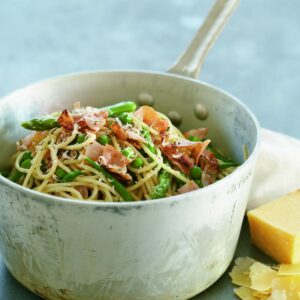
Piling on a few extra kilos over winter is fairly common, but if you want to maintain your healthy weight range, these lifestyle tweaks can help.
As the cooler weather sets in, we tend change the food we eat, and staying active can be more of a challenge. Instead of salads and light dishes, we want more warming, comforting food. And rather than heading out into the weather to exercise, a warm house beckons. Sound familiar? The good news is we can enjoy winter comforts and keep our weight within a healthy range too.
1. Know your appetite
Appetite is more than physiological hunger. Psychological and social influences also affect what, when and how much we eat. We also eat more when there’s a greater choice of foods, larger servings or when we share a meal. And boredom, stress and grief can affect appetite in different ways. Hormones busily send signals to the brain to help us know when to stop eating, but it’s easy to override those messages.
2. Rate your hunger
One way to get in touch with our bodies’ signals is to rate our hunger. Rating hunger before a meal or snack helps us recognise whether we are eating because we are truly hungry or eating out of habit or an emotional need. Ideally you want to eat when you’re hungry (before you become ravenous), and finish when you’re satisfied, rather than overfull. Rating hunger after a meal or snack helps us realise we don’t need to eat until we’re chock-full to survive until the next meal. If we’re not hungry by the next mealtime, we can reduce the amount we’re having at meals.
3. Choose more satisfying options
Foods that keep us full for longer may help stop us overeating at our next meal.
Fibre
Research shows fibre may reduce how much we eat at the next meal because we’re not as hungry.
• Enjoy a high-fibre brekkie cereal.
• Use wholegrain breads, rice and pasta instead of white.
• Add beans or other legumes to salads and stews.
• Enjoy hummus with grainy bread, crackers or crudites.
Protein
Research shows protein is more satisfying than carbohydrate or fat, both at mealtime and for the next few hours after. Include protein-rich foods with each meal – think eggs, fish, tofu, poultry, red meat in moderation, legumes and low-fat dairy.
Low-GI foods
High-glycaemic index (GI) foods give a sharp peak to our blood glucose, and the trough afterwards triggers hunger. Foods with a lower GI are digested more slowly and give a more steady release of glucose into the bloodstream, so they don’t trigger hunger in the same way. Lower-GI foods include milk and yoghurt, wholegrain cereals and breads, legumes and most vegetables.
Veg it up
Non-starchy, low-kJ vegetables help us feel full. The water and fibre in them add weight and volume, so we fill up for fewer kilojoules. Bulk up meals and snacks with delicious non-starchy vegetables like baby carrots, sliced capsicum, cherry tomatoes, broccoli, beans, beetroot, cabbage, cauliflower, celery, cucumber, eggplant, leeks, mushrooms, salad greens, silver beet, spinach, snow peas, spring onion and zucchini.
Healthy fats
For women, it’s been found that unsaturated fats stimulate a hormone which helps us feel full for longer. You don’t need to go overboard though, because fats can be higher in energy than fibre, which stimulates the same hormone (cholecystokinin). Try adding a handful of seeds or nuts to meals and snacks, and drizzle a little olive oil over salads or vegetables.
4. Get a good night’s sleep
A growing body of research links how long we sleep and the hormones leptin (suppresses appetite) and ghrelin (stimulates appetite). One study found habitually sleeping for fewer than seven and three-quarter hours was associated with a higher body mass index (BMI), as well as reduced leptin and elevated ghrelin levels. Other studies on the effects of one or two days of sleep deprivation have found similar changes in hormone levels, and participants also reported increased hunger and appetite levels.
5. Foods to beat winter weight gain
It’s easy to reach for comfort foods that aren’t always the healthiest choice. Here are five foods you can happily indulge in.
Cup of tea, anyone?
The combination of caffeine and catechins in green tea can help increase heat production and fat burning.
Vegetable soups
A US study found starting your meal with soup can help you consume 20 per cent fewer kilojoules at your meal.
Non-starchy veg
Aim to fill half your plate with colourful vegies. Their fibre helps you feel fuller, longer.
Beans and other legumes
Replacing half of the meat in recipes with legumes is an easy way to cut kilojoules while boosting the fibre and protein.
Stewed fruit
Stewed apples, pears or rhubarb paired with Greek-style yoghurt will help satisfy those sweet cravings.
Article sources and references
- Flood JE & Rolls BJ. 2007. Soup preloads in a variety of forms reduce meal energy intake. Appetite. 49:626-34.
- Kira et al. 2006. Effects of chilli consumption on postprandial glucose, insulin, and energy metabolism. Am J Clin Nutr. 84:63-9
- Ma et al. 2006. Seasonal variation in food intake, physical activity, and body weight in a predominantly overweight population. Eur. J. Clin. Nutr. 60:519-28
- Mattes. 2005. Soup and satiety. Physiol. Behav. 83:739-47
- Penn State. 2007. Eating soup will help cut calories at meals. Available at sciencedaily.com
- Subar et al. 1994. Differences in reported food frequency by season of questionnaire administration: the 1987 National Health Interview Survey. Epidemiology. 5:226—33
- The University of Auckland News. 2015. Flavonoids reduce cold and cough risk. Available at auckland.ac.nz/en.html
- Van Staveren et al. 1986. Seasonal variation in food intake, pattern of physical activity and change in body weight in a group of young adult Dutch women consuming self-selected diets. Int. J. Obes. 10:133-45
- Yoshioka et al. 2004. Maximum tolerable dose of red pepper decreases fat intake independently of spicy sensation in the mouth. Br J Nutr. 91:991-5.
www.healthyfood.com










